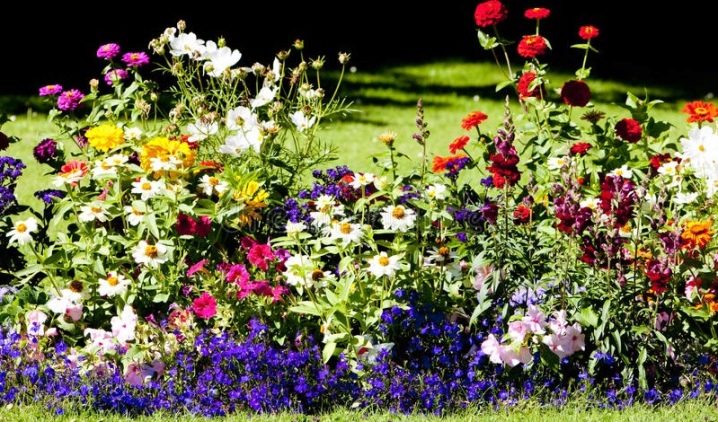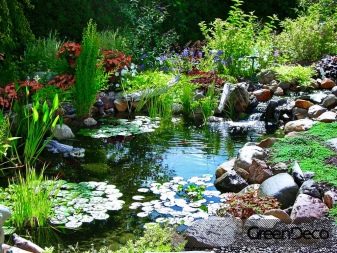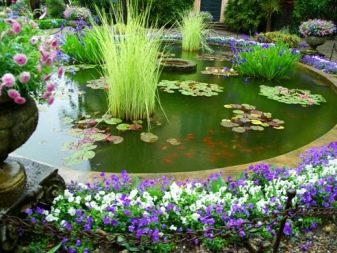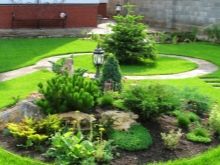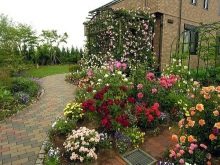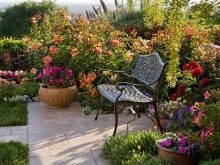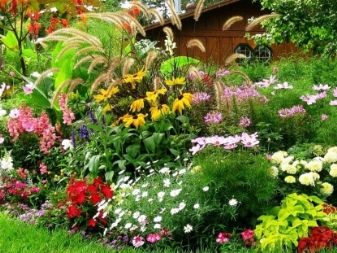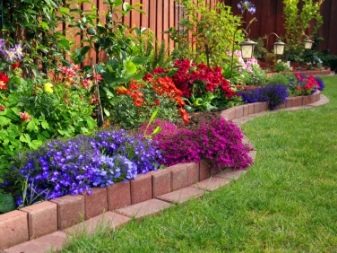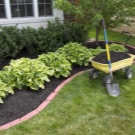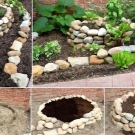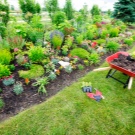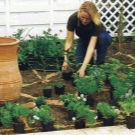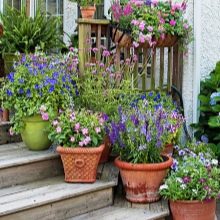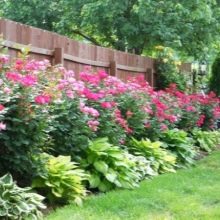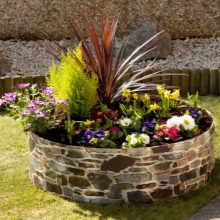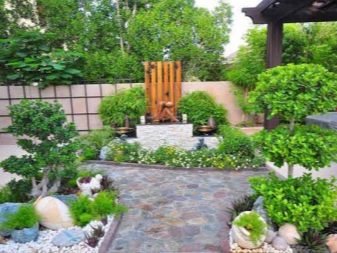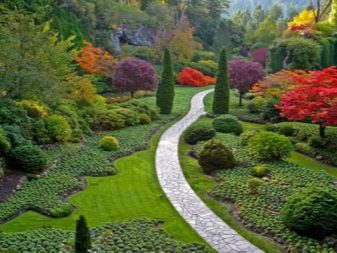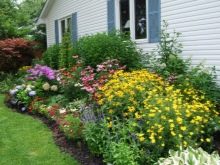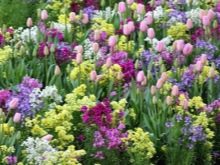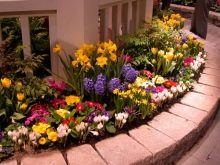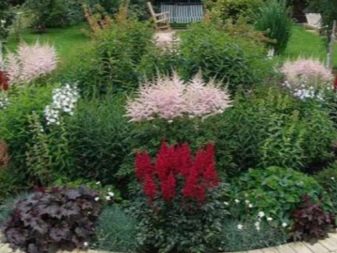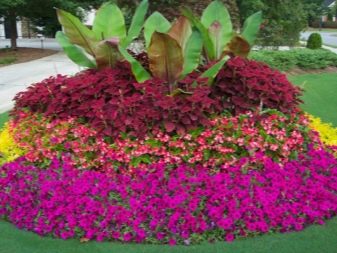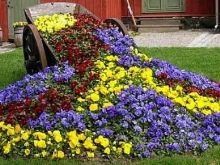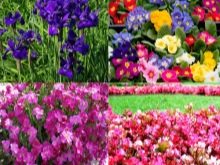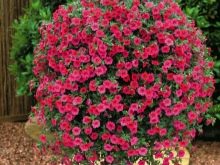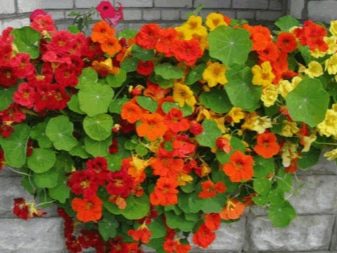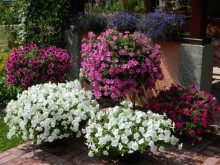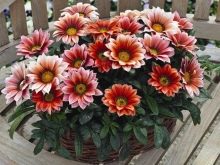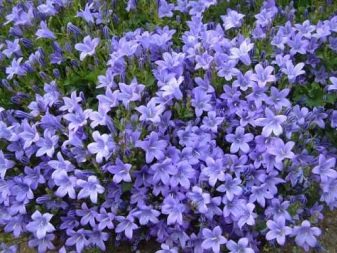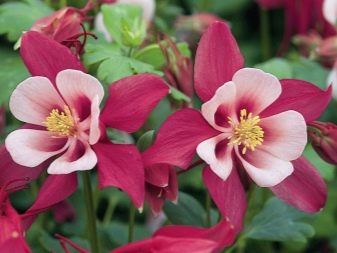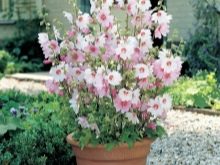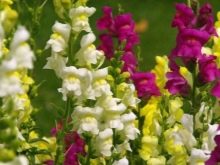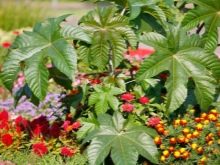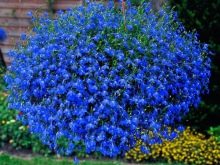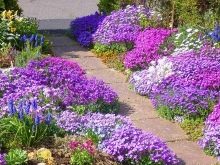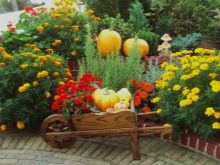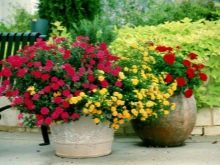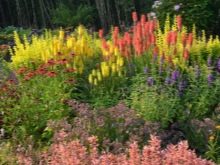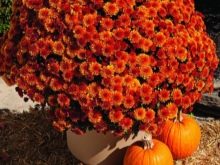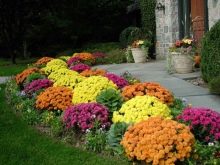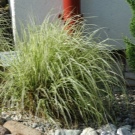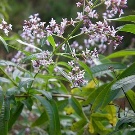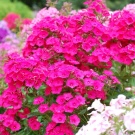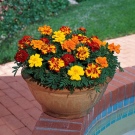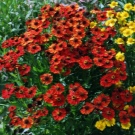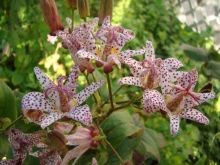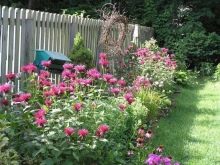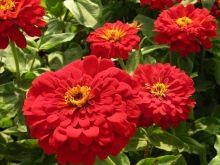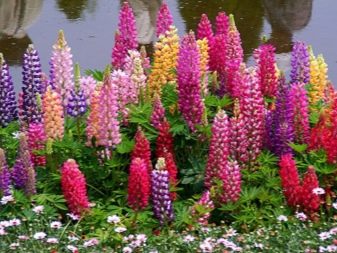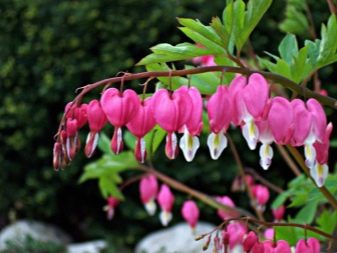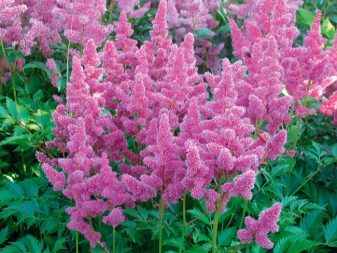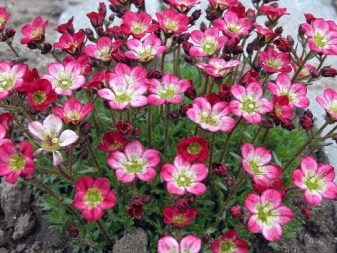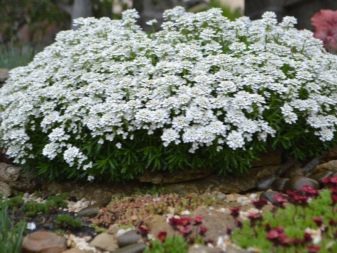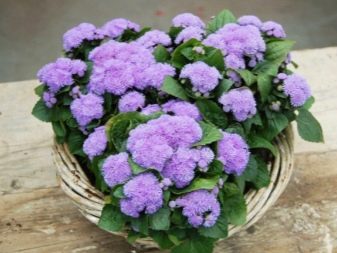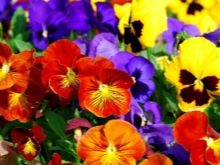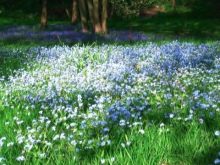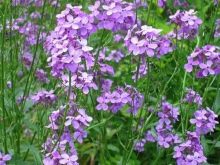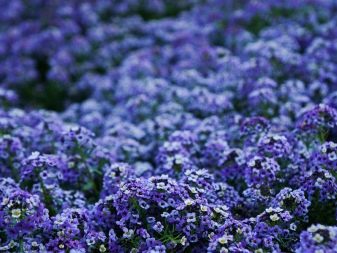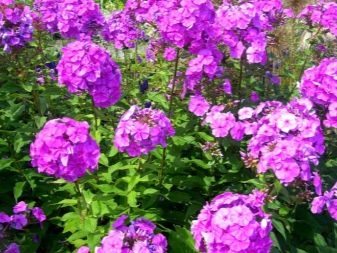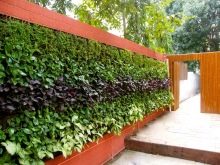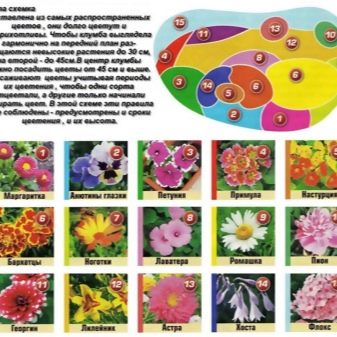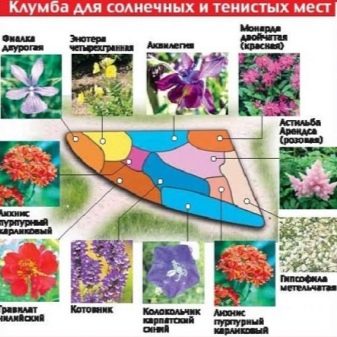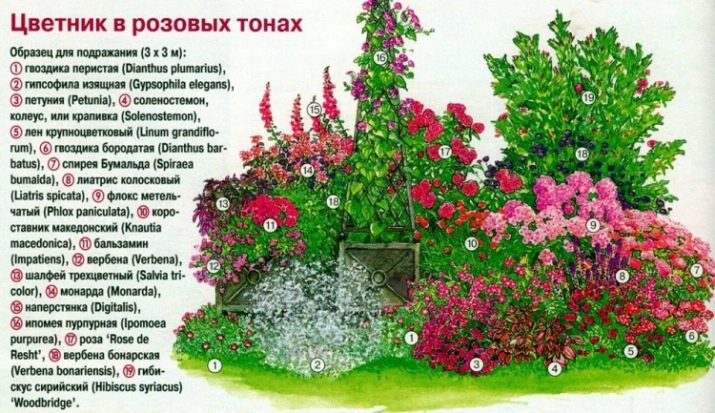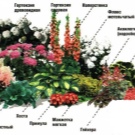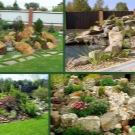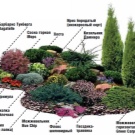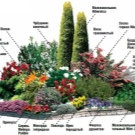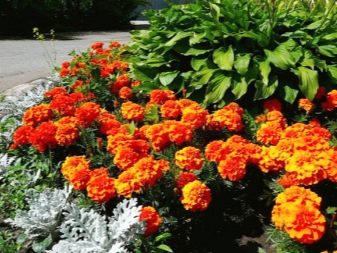Flowers for flower beds: what to choose and how to care?
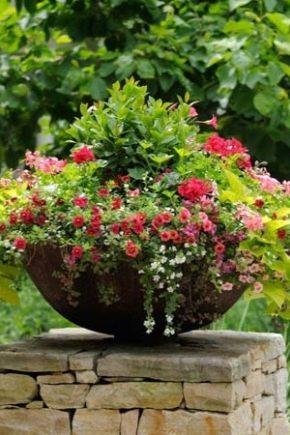
In the rapidly fading petals more life than in the centuries-old soulless blocks of granite. A deserted courtyard unwittingly casts thoughts on improving landscape design. Before the beginner, who decided to organize a small garden with his own hands, there are questions of choosing flowers for flower beds and caring for fragile beauty.
Special features
The main goal of a novice gardener is to create a cozy corner of a picturesque garden. To implement this idea, use a variety of ornamental plants for decoration flower beds.Perennial plants that require less maintenance will be an ideal helper. They will provide a permanent decorative effect.
However, it is not recommended to start the selection of plants immediately, because first you need to determine the technical characteristics of a flower bed or flower garden:
- local landscape features. It is necessary to determine the individual design of the flower garden. Hills can be used to implement creative ideas, and small pits - as a natural flower bed. It is also possible to cement them. The latter is acceptable when creating a small pond with decorative water lilies;
- relief removal. For perfectionists who decide to start building on flat terrain, it is recommended to level the site to avoid unpleasant consequences in the form of earthen slopes;
- size of the territory. It is necessary to make a plan of the garden plot in advance, calculate the number of plants. For example, without taking into account the area of paths, you can get lost in the green wilds;
- location of the future flower bed in relation to sunlight. For many shade-loving plants, constant direct sunlight is destructive.Flowers of this type require a slightly darkened landing site.
The spectacular and bright image is created thanks to the combination of various colors and landscape objects. Optimal perception is possible with the correct calculation of plant growth in relation to the point of view. Favorable demonstration involves planting small flowers near the roads with a gradual increase in the shape and size of seedlings to remote areas of the territory.
It is recommended to take a closer look at the perennial plant combination. With an inappropriate combination, you can accidentally destroy the created image. To avoid unpleasant surprises, you must first calculate the flowering period, take into account the shape, the combination of the color of the petals and leaves, plant growth.
When operating the elements, it is recommended to achieve maximum harmony between the architecture and the adjacent landscape solution of the site.
Where to begin?
Before taking up the design, the site owner must evaluate it correctly. Even if the landscape seems unsuitable, on it, in any case, it is possible to "blind" the picturesque landscape. To begin with, the plot should be cleared, having previously taken into account the relief, windiness, soil and illumination.Despite the fact that many plants are unpretentious in the care, for all it is necessary to follow the rules for choosing the best soil for planting seedlings.
Fertile soil is needed for the flower bed, which will ensure a long flowering period.. It is necessary to choose a place for planting immediately, as a transplant is always a painful procedure for flowers. After the layers of the earth are laid, and the flowers are planted, the plants should be separated by fences.
These actions are necessary so that the seedlings do not grow, do not "fight" for the territory among themselves. Sun-loving plants are recommended to be planted in open areas. In the shade, they will give little inflorescences, pulling up. Low-growing requires additional watering. This must be taken into account when planting plants with each other.
In order not to get confused when planting, you should make a schedule of planting plants. Such actions will help not to get lost and provide the effect of continuous flowering of the site. For example, experts recommend planting bulbs in October, while nasturtiums and marigolds require planting in early spring.
In summer and autumn, it is better to spray plants with pest control. Also, you can not overdo it with dressings.Nitrogen fertilizers contribute to the active growth of greenery, interrupting the flowering period.
Landscape Design Trends
Initially, you must choose the landscape or classical stylistic direction. The latter implies strict obedience of plants and decorative elements of a single creative thought.
The approach requires time-consuming care, as all plants need timely haircut. However, efforts are paid off by the visual embodiment of a refined style with characteristic features:
- well-planned plot area;
- harmonious use of geometric shapes in the process of cutting;
- the dominance of green over flowering plants;
- ideally flat terrain.
However, for lovers of nature there is a landscape style - the exact opposite of the classics, as close as possible to the natural design. Near the house will grow lush vegetation, endowed with asymmetry and smooth features.
The main features of landscape design are expressed as follows:
- free distribution of plants;
- the natural form of shrubs and trees;
- an abundance of flowering and fruit seedlings;
- flower compositions, collected in single groups according to the compatibility of shades and similarity of care.
Landscape type does not require additional costs and effort. The big plus is that it can be used even in a small area with uneven terrain.
Popular in the front garden
Finding the perfect combination of colors for the garden is no easy task. Chaotic set and indiscriminate landing will not provide a beautiful landscape. The main thing - do not get confused, and view a list of popular plants for flower beds. Based on detailed instructions, you can reach the picturesque picture in the yard. For trial experiments in the first year it is recommended to plant annual plants.. They will be liked by connoisseurs of diversity.
With simple landscaping, unpretentious flowers are irreplaceable. You do not need to spend a huge amount of time and effort on caring for them, so this is an excellent choice for those who want to decorate the landscape with their own hands.
Annuals have several advantages in a variety of choices:
- solar nasturtium it is heat-loving and prefers bright places, but it is badly experiencing a transplant.Large seeds are able to winter in the soil, which guarantees the appearance of green shoots next year. Flowers have a subtle pleasant aroma that emanates sweet calm. They can be grown both in flowerbeds and in pots in open areas. Pleasant surprise and beneficial properties of medicinal plants. All parts, in addition to the roots, are quite edible;
-
salvia grows in areas rich in sun and moisture. In addition to the above parameters, she no longer needs anything to decorate a flower bed with red cone-shaped inflorescences. For those who prefer a unique style, suit royal salvia. Orange flowers will complement the look with a touch of human blood, which can change depending on the time of day;
- petunias dazzled with a variety of shades. The tender buds of the shape of small gramophones surprise with resistance to direct sunlight. It is enough to scatter a small amount of seeds on the ground - and this will ensure their rapid growth and development. Petunia is planted in the beginning of June on open ground, as repeated freezing can destroy it;
- gatsania - multi-colored daisy originally from South Africa.Differs in the big sizes. Flowers are combined with black soil, brightening the dark color of the soil. In most cases, they are used to create intricate patterns in combination with low-growing plants, and also as an object of decoration for tracks. There are annual and perennial varieties to create garden compositions in open areas;
- purslane is a natural carpet. The creeping plant breeds by self-sowing, so that it will not have to be planted next year. The end of March is optimal for sowing when there is already enough sunshine outside. Unpretentious saplings do not need watering and top dressing, preferring the dry or sandy soil.
More experienced gardeners prefer to plant perennials, which bloom begins with the first spring heat.
The early period is characterized by the appearance of snowdrops. Next, they are replaced by spring compositions, which are based on tulips, iris and hyacinths.
The chaotic variety of colors can be permanently tightened and frightened by a wide choice:
- periwinkle proudly denies artificial watering after planting. It can be left unattended.Soon the periwinkle grows wild, growing into a decorative carpet. Dense areas can be trimmed to give the desired shape;
- often found in gardens aquilegia, whose name in the people - "flower elves". Tender buds bloom for a long time: from early spring to the first blows of frost. Petals mostly have a gray tint. It grows in the form of a shrub, forming both low and high vegetation. The development of aquilegia requires a soil equipped with a good drainage system, and partial shade, where the flowers get a more saturated color;
- laureate known by the name “wild rose” with large buds, reaching 10 cm in diameter. The flower justifies its name, because it is picky against the soil, drought-resistant and adamant under the strong wind. Landing is at the end of spring. In the cut form, individual specimens are capable of not losing the decorative appearance during the week. Shades of petals range from yellow to purple;
- pelargonium - A common home plant that repels insects. Better known as geranium, it quickly mastered the new terrain,easily growing and multiplying. Perennial light-loving plant unpretentious in the care, but blooms in well-drained soil. At the beginning of spring it needs fertilizing with potassium content;
- talking title "Snapdragon" easily spread thanks to greek mythology. Flowering occurs in June, lasts until the first frost. Initially, seedlings grow slowly and sluggishly, but after the first period, a lush flowering begins, increasing the abundance of buds from year to year;
- castor pot does not tolerate landing. Saplings long get used to the territory, even in the presence of top dressing, preferring to grow in moist open areas with a high level of humus. The plant does not like frosts, so planting seeds is possible only in mid-May;
- lobelia gives some charm and charm to the landscape from the first summer days to the end of autumn. The plant is covered with many buds of delicate shades: from purple to sky blue. The flower is picky. It grows only on loose, not too fertile soil with regular watering. The place should be well lit. Lobelia needs constant mineral supplements.Landing should be done at the end of February;
- Aubrieta characterized by bright petals, colors range from pale pink to blue. The flowering period is in the middle of spring and lasts until the end of summer. The plant retains foliage in the winter season, which makes it incredibly resistant to strong frosts. Aubrieta is unpretentious in care, rarely when additional feeding is required.
Perennial plants have gained popularity due to the fact that they do not need to be planted every spring. To create a permanent landscape design such flowers are the best fit. When selecting colors for mixborders, you must also take into account the parameters of plants. The central position should take the flowers with large and most bright buds.framed in decorative greens and modest inflorescences of short stature
. Tall plants are planted in distant beds on the periphery of the site or in the center of multi-layered flower gardens.
Autumn
Autumn time completes the flowering period of most perennials. At this time of the year, foliage and cereals provide decor. In order not to lose bright summer colors, you can plant autumn compositions.. The leading position is occupied by an annual plant, whose name is Astra. Flowers of bright shades grow from late spring to late autumn, but the advantage lies not only in the color and duration of flowering, but also in large branched inflorescences. The height of asters combined with stunted and tall plants, as they have a wide range of varieties.
Chrysanthemums will be a great helper. Their flowering season begins in August and lasts until the first frost. The color scheme excludes only the blue color, however in the autumn they use mainly red shades in order not to disturb the natural seasonal image.
Perennial dahlia blooms in warm tones. Lush inflorescences delight the eye from the end of July to the first blows of frost. The only negative is that they need to be sheltered for the winter, because the tubers die at temperatures below zero degrees.
In order not to deal with a headache when making the necessary combinations, it is recommended to use a ready-made scheme, or select individual specimens from it:
- aconite of Karmichel;
- veinik;
- phlox;
- tricyrtis;
- zinnia (majors);
- marigold;
- gelenium;
- lemon verbena;
- taperver;
- monard
Autumn compositions are in combination with natural colors that range from gold to maroon.
You should not take tall plants. They create an image of lush vegetation that does not look harmonious in the seasonal period of general preparation for sleep. The collection of low colors in full implements bold ideas in curious patterns.
Shy of love
Owners of areas lost in the shadows have a hard time choosing a flower arrangement. Before them - a wide range of plants that prefer open space, but dying in the shade. However, the problem of gardening is resolved by a list of shade-loving plants, the beauty of which is not inferior to sun-resistant species:
- lupine is a powerful bush, reaching 150 cm in height. Finger petals are assembled in a long socket, pleasing the eye for several seasons;
- dissentra - low-growing seedlings with carved petals, resembling folded wings of birds. Landing is carried out at the end of spring or at the beginning of autumn as part of a seasonal composition;
- astilba possesses long fluffy inflorescences that do not require careful supervision.The plant does not need abundant watering, but if the owner of the garden wants to see abundant flowering, you should water the astilba once or twice a week;
- stonework echo their name, preferring to grow on drained poor soil. In the penumbra, they form a "pillow", blooming with simple pleasant buds during the summer period. Despite the fact that saxifrages grow abundantly in the sun, they feel great in the shade, without requiring additional care.
Diversity will bring evergreen plant varieties, flowers with lush leaves. Hosta will appeal to lovers of lush greenery. Wide leaves of bright colors cover the ground, keeping the remnants of moisture, so that the plant does not need frequent watering. Woodruff will strike with an unusual form of foliage, while a symphandra will make a beautiful pair with him. Her carved buds look exotic in combination with lush vegetation.
Undersized
Thanks to annuals, every year the opportunity to experiment with flower arrangements is given, creating new picturesque flowerbeds. The most popular in this issue of petunia, however, there are many annual plants that are not inferior in merits:
- iberis and ageratum. Unpretentious shoots create flowering carpets, often adorn the alpine slide. They prefer to grow in the open area among other plants with which they get along well;
- unrelated culture of pansies able to grow in sunny and dimly lit areas, but they are greedy for moisture, requiring constant abundant watering;
- forest forget-me-not pleases with flowering tender buds of heavenly shades from late spring to early autumn;
- at night will help hesperis. Night violet has not only flowering in the moonlight, but also a delicate aroma covering the entire garden area. Prefers moist soil in shady places.
However, annual plants, as a rule, rarely have lush growth. So that the plot or the flowerbed does not look scanty, it is worth trying to combine “one-year-olds” with undersized perennial saplings. A big plus is also the fact that perennials are able to create an unforgettable composition for a long time.
Among the favorites of the garden plots there are the following types:
- arena crimson. Bloody "carnation" blooms in July and continues to bloom until mid-October.It prefers to grow on sandy soils, the color of buds of white and pale pink shades;
- sea alissum prefers sunny areas with variable irrigation. The color of the buds is represented by yellow-pink colors. The plant survives at a temperature of -11 degrees, which indicates extreme endurance to climatic conditions;
- sage able to please the eye throughout the whole summer. It grows well in shaded areas, without the need for constant care;
- phlox bloom more than half a year in the form of shrubs with spherical buds.
Experts recommend planting near only those plants that require the same conditions for growth, for example: the same soil and type of light.
Vertical
Today has become relevant use of vertical gardening. In a short time it is possible to create a real masterpiece of a picturesque corner of nature from a callous architectural stone. The project is possible to do it yourself. It is only important to have the necessary support - gratings, cords or columns, and the desire to care for climbing seedlings. For landscaping, you must use frost-resistant and unpretentious creeping plants. The most common are liana seedlings.. They are able to grow to a height of 25 meters, while creating a dense hedge.
A special place is occupied by girlish grapes.which flourishes in the autumn. It is resistant to frost, does not require careful maintenance, preferring to grow on the trellis. Thanks to the antennae, the grapes cling to any vertical structure. For it does not need to make additional designs.
Honeysuckle, clematis and actinidia are used for landscaping tree trunks and bearing structures, but in no case should hops be used recklessly. It is unpretentious and grows rapidly, so much so that it is difficult to control. "Aggressor" prefers to be hammered into the cracks, and its root system destroys the foundation of the building.
Colorless
To make summer crombas not look too motley, the composition is diluted with non-flowering plants.
So, the following types are perfect:
- spicy herbs - basil and mint. They will serve not only as an object for decoration, but will also be useful in cooking. They are unpretentious, create good combinations that can compete with bright petals.The pleasant aroma of spices will brighten up the sharp odors of flowering plants;
- ornamental deciduous plants It should be chosen carefully, because not all greens can survive the changes in the local climate. It is advisable to start with shrubs that do not require careful maintenance. Evergreen boxwood and barberry will help to train the hand due to the fact that they tolerate bad conditions and strong pruning;
- veinik - ornamental grass, which perfectly tolerates the dry season, is able to survive on rocky soil. Creates a unique alpine slides;
- the emperor It is demanding for irrigation, however, this disadvantage is compensated by a beautiful combination of red-green foliage. Color persists throughout the year.
For large areas, it is important to begin planting with conifers.d playing a role in the landscape. They do not change throughout the year, which effectively looks on a snowy background. Small trees play the role of the frame, giving the opportunity to grow around any composition. With a uniform distribution, the plants will become the center of landscape design. Dwarf junipers and ornamental spruce are often chosen from hvoynik. They will not bad decorate the alleys in the blooming garden. Usually they are planted in rows like a hedge. A big plus is the variety of forms: from round to columnar, which creates peculiar partitions in the garden.
Coniferous plants are easy to cut if necessary. These procedures will not affect their growth and development. Dwarf plants are recommended to use as borders. For example, spruces and cypresses will fence off a picnic area. It is recommended to plant conifers on a large area, which will create shade and coolness in the hot summer.
What plants are combined?
When choosing a composition, you should be guided by your own taste, following the necessary recommendations for creating an ideal garden:
- Foreground should always be occupied by plants of short stature. For example, chrysanthemums are perfectly combined with phloxes, which create the necessary background. Pansies can draw attention to the edges of the alley;
- it is not necessary to plant small beds in a large number of flowers. The struggle for soil and light can lead to the death of some plants, and this is a waste of effort;
- tall grasses difficult to combine.For this purpose it is easier to choose a composition from low-growing greens;
- In the garden it is necessary to combine non-flowering seedlings with abundant inflorescences of various species. Coniferous fine dilute bright colors that look out of place in combination with each other;
- should pick harmonious combinations. For example, with red peonies you can plant purple phlox.
In the case of complete confusion in terms of choice of composition, you can rely on the recommendations of experienced gardeners, who made up the combination of the most popular colors with each other or with other plants.
Fateful Lady of the Blooming Garden
The queen of landscape design - a rose - can become an ornament to any garden, but sometimes there is a feeling that small groups of spiny stems look lonely and poor. Red buds create a classic composition with lilac and blue.
The perfect combination implies a combination of lilac, tamarisk, snow bug and sea buckthorn with roses. The diversity of coniferous plants, the most suitable of which are thuja and juniper, will help. An ensemble with evergreens will be made up of mahonia and cotoneaster.
Delicate combination of tenderness and beauty
Lilies are able to transform any garden, adding shades of all colors: from snow-white to blue-black. Before picking a bouquet for a flower bed, you should pick up groups of plants according to the timing of flowering. Lilies acquire aristocratic and dominant status among other plants, so the "retinue" should be more modest. For example, gentle colorsEty look great with peonies, forming a symbiosis. Peonies' lush leaves protect the soil from drought., requiring similar care conditions.
In this regard, the irises are poorly combined with lilies.. The latter require abundant moisture, while irises after the flowering period can not be watered. The same goes for roses, which constitute a fierce competition in the battle for attention. Spicy composition is formed in combination with the hosts, well growing in the shade. They are comparable in flowering time with daylilies, so they will complement each other throughout the season.
For a harmonious landing, for which you do not need to make alterations, you need to choose a central view. It should be repelled when forming a flower composition.
Marigold
A flowerbed of marigolds will give vent to fantasy in combination both between varieties of one plant and with other representatives of the flora. Tagetes is an unpretentious plant, not demanding either to watering or to the soil. It is recommended only to select the same flowering period. - from the end of June to the first frost.
Marigolds are more suitable for small bedswhere the loose center should rise above the densely planted periphery. Tagetes any color look great on a background of white petunia.
The composition can be made up of several tiers like an alpine slide. In this case, the center of the flowerbed is a dwarf coniferous plant, for example: a round juniper, from which purple and white petunias will fan out. The lowest level will be occupied by marigolds, diluted by a silver colored scab.
Flowers for timid natures
The flowering of chamomile falls on the beginning of summer, from which it is easy to conclude that the simplest combination will consist of wild flowers. Blue bells and red poppies will remind you of your childhood in a fun combination. Provided that daisies take a central position in the flower bed,It should be decorated with a decorative fern, but the choice of an exotic composition should be guided by unnatural images: unruly orchids and roses of aggressive colors will play with painterly colors against the background of modest daisies.
The only axiom says: always choose a green background of non-flowering plants for daisies. They will not let fragile colors get lost in the tumult of other colors.
Gladiolus - flowers generated by a gladiator sword
Capricious gladioli create splendor in their own right, riveting the eye to the combination of picturesque petals on the lush green of the leaves. However, the flowering period is short enough for them, so you should pick flowers that will be:
- accompany the birth of the buds (daffodils and tulips of the required coloring);
- strengthen the position of gladioli during the flowering period (lush peonies);
- mark the end of the season (combination with hydrangea).
Dahlias should not be planted nearby, since large inflorescences will compete with each other. Another thing - the background of evergreen shrubs, lawns or conifers. Pastel colors of some varieties of gladiolus will be beneficial to emphasize the bright petals of other seedlings,while the scarlet flowers stand out due to the white tones, and the chocolate buds will look good with cream shades.
Begonia - Aphrodite Garden
Begonia manifests itself in a volumetric mixborder over a large area. Unfortunately, in the garden so not swinging. On the flowerbed and alley, these flowers will perfectly fulfill the role of decoration in the foreground. Begonias beautifully decorated flower garden in the form of a low hedge.
In combination with silver and white cineraria and lobularia, different colors of begonias will play in a new way. Flowers can be combined with each other, as well as with other annual plants.
Flower compositions can not only be a duet, but also win in more complex combinations. It is only necessary to choose the best period of flowering and harmonious shades of the petals, and this requires creative ideas and a creative approach. A few small experiments will turn the garden into a chic place to relax.
Design
Curious ideas for the garden, embodied with their own hands, are able to decorate an inconspicuous garden. Even a parcel purchased with plantings can be corrected by experimenting with shrubs, rock gardens and water zones.The latter will give the site individuality and a unique look, being an additional source of moisture.
The simplest solution is to create a small pond by digging a pit of a certain size.. Next, you need to pour it with cement, strengthening the edges, providing the necessary waterproofing. At the end, it remains only to fill the mini-pond with water, and equip it with decorations to taste. The shore can be lined with cobble or gravel, plant plants that require an excess of moisture.
Creative idea can serve as a decorative waterfall, which is recommended to elevate in oriental style. Also in a large area it is possible to equip a cozy garden with a fountain and a rock garden in the center. The elegance will give a picture of a dry stream of small gravel and pebbles.
Several large natural stones, which remained after cleaning, it is possible to lay them on top of each other in order to create a rock garden. It is possible to fix their position with cement mortar. The remaining cracks can be filled with fertile soil, finally planting ornamental plants.
Inspiring Beds: Work Examples
The original idea is the creation of palmettes from fruit trees.The hedge is created by excision of the crown of seedlings. With this approach, the trees will grow in width, intertwining with each other branches. Growing in height fruit trees absorb more sunlight, thereby increasing their yield.
Palmettes visually increase the area of the site, harmoniously merging with ornamental shrubs.
In the next video you will find a master class on creating a small flower garden.
